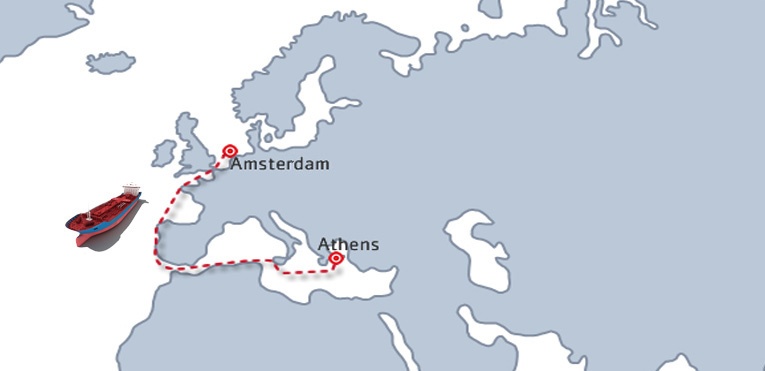How China's new Silk Road is changing the global shipping landscape
---
Fourteen centuries have passed since China officially established trade routes along the legendary Silk Road to central Mediterranean ports. Today, the much more ambitious One Belt, One Road concept comprises expanded naval and land connections, including fast growing port hubs like Piraeus and rail services such as the Zhengzhou-Hamburg link.
---
The first time I wrote about Chinese investment in the Greek port of Piraeus was in 2012. I was overwhelmed.
Luckily, a former exports-imports merchant and family friend was there to enlighten me. "You see this shipping route?" he said, outlining with his finger a long sweep across the map from the Mediterranean all the way around the western jut of Spain and up to the North Sea. "No more. Combined with a proper rail network, Piraeus could surpass Rotterdam in a decade". The slow boat to Athens
The slow boat to Athens
As an economics graduate of East Germany, Gregory knew well the importance of a fast delivery time and efficiency, tricks of trade relations that the Chinese have known since the 7th century, when the first of seven Byzantine embassies was established in China, sealing the growing commercial and cultural link with Europe.
Almost 14 centuries later, the legacy of the Tang dynasty rises again. Introduced by Chinese president Xi Jinping in 2013, the One Belt, One Road initiative is pursuing strategic economic and political goals, connecting China, western Asia and Europe through modern trade, communication and transportation networks.
The gateway to Europe
Greece, along with other countries of the Balkans and Eastern Europe, poses great significance to Chinese interests, as the recent visit of the Greek PM Alexis Tsipras to China shows. This took place right after the Greek parliament ratified the acquisition of 67 percent of Piraeus Port Authority by the Chinese shipping company COSCO.
Due to its size and proximity to the Suez Canal, Piraeus represents an integral part of the maritime component of the new Silk Road project, turning into a transhipment hub for Chinese and other Asian exports to central and northern Europe.
The volume of containers handled in the port has increased to 3,493 thousand TEUs (Twenty-foot equivalent) up from only 437 in 2008 (Eurostat data 2014), while its transhipment incidence exceeds 80 percent.
Among others, the competitiveness of Piraeus lies on the shorter duration (and thus cost) of the journey from Chinese ports. It takes 24 days, for instance, for a ship to reach Piraeus from Shanghai - that's at least 12 days less than the journey duration to northern European ports, like Antwerp and Rotterdam.
But port development is only half of the story. As Gregory put it, "This goes hand in hand with land transportation of goods to central Europe.”He was talking about rail, an old faithful mode of freight that completes the supply chain for manufacturers like Huawei, ZTE, Hewlett Packard, Sony and e-commerce companies in Asia, such as Alibaba.
The Greek railway network, used for transportation of goods to logistic centres in Hungary, Romania and the Czech Republic, already works at full capacity and therefore its infrastructure development is crucial to the Chinese interests, let alone to Athens.
But if Chinese investment in the Mediterranean is the "head of the dragon", where would the rest of it lie?
Rail as key part of the Economic Belt

The formation of new trade routes suggested under the new Silk Road concept is not merely an exercise in vanity. Geoeconomics analyst Dimitris Stergiou (University of the Peloponnese) explains:
"China is evolving from a 'global factory' to an exporter of high end technology and high value goods". And perhaps more significantly, there is an "increasing need of the Chinese middle and upper classes in branded goods and perishable products - such as food. In both cases, the reduction of shipping duration is determinative, even with a small rise in costs".
It's no wonder hub ports such as Rotterdam are fervently seeking to establish their own rail connection with China to tap demand in agricultural and food exports from Europe-based companies.
Rail freight is still much cheaper than air freight and faster than ocean freight. A good example is the rail cargo service linking Zhengzhou, capital of Henan province, with Hamburg in Germany, launched in 2013. The 10,214 km Zhengzhou-Hamburg route has a journey time of only 12-16 days, less than half the time needed for containers shipped via the maritime route. Multimodal services are also constantly introduced, offering for instance "less-than-container”load and "full-container" options.
Businesses on a fast track
For medium-to-large Dutch businesses exporting to China, using the rail link is all but inevitable. John Paul Vegt, of G&D Europe, an exporter of organic milk and baby food to China explains the choice in a recent BON video that showcases the type of Chinese-European venture we are sure to see more of in the future. Though there are details to be worked out he says confidently: "We will definitely use the train, no matter what."
Filling urgent orders from China by air freight had already set back John Paul and his partner Liu Yong Gao an eye-watering 4 million RMB this year. And foggy conditions at sea once slowed down their precious cargo by an additional two months.
Zhengzhou is just one of the non-coastal cities of China bidding to become a logistics hub through rail infrastructure development, in an effort to catch up with the more developed port cities, like Tianjin and Qingdao.
Of course, there are other rail links to Europe, like the Yiwu-Madrid and Suzhou-Warsaw; it should be noted these routes are often faster (but connected to) than the Trans-Siberian Railway Line and up to July 2016 cargo trains connected 16 Chinese cities with 12 European cities.
Locomotive for global growth
Both the maritime and land routes are distinctive features of the One Belt One Road concept, for it implies heavy investment in all kinds of infrastructure: railroad lines, airports, utilities, bridges, highways, energy plants, telecommunication, shipbuilding and repair facilities. This focus on real economy projects, along with the prospect of boosting domestic demand in China, suggests a "win-win" model of cooperation, much more reliable than controversial projects such as the TTIP (Transatlantic Trade and Investment Partnership). There is not a single country in Europe, great or small, that would not wish to tap more portions of the ever growing Chinese market, or benefit from more foreign investors and cash. At the same time, China spreads its wings, securing vital political and economic interdependencies with Europe, which will allow Beijing to parry the competition moves made by the United States and its allies in the Pacific.
But more importantly for everyone, the new Silk Road endeavour entails an opportunity for global growth, stemming from investment in technology, knowledge and the real economy.
Additional reporting by Vasso Asmanidou.







